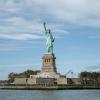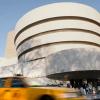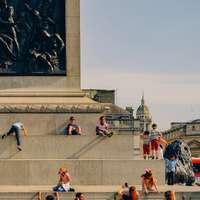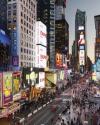By Maya Singer
January 2024
Gotham’s thriving scene offers some of the world’s best art, theater, shopping, and dining. Only question is, how much can you fit in?
Your essential guide to the best things to see and do in New York. Find more travel inspiration for more amazing cities here.
Pop songs aren’t usually subject to fact-checking, but Alicia Keys’ Empire State of Mind stands up to scrutiny: In New York, as the lyrics say, there’s nothing you can’t do. This city’s got it all—great art, fabulous food, world-class shopping, vibrant street life, cultural offerings of every variety. The sheer abundance of goings-on in New York City presents a challenge to the visitor: How to choose?
Most travelers wind up spending much—or all—of their time in Manhattan, the busiest and most culturally packed of the five boroughs. There’s a lot of action to uncover in the slender island’s walkable 22.82 square miles, and one of the great pleasures of Manhattan is to get out and just wander around: Pick a neighborhood, do some people-watching, let the city’s hyperkinetic rhythms vibrate through you.

The Statue of Liberty can be seen from the Staten Island Ferry
Pause amidst the commuters to admire Grand Central Terminal
That’s the main attraction here, really—the New York hustle and bustle that has inspired legions of groundbreaking creative types. Walt Whitman, Langston Hughes, Andy Warhol, The Ramones, Martin Scorsese, Jean-Michel Basquiat, Lin-Manuel Miranda, Lady Gaga… the list goes on. And on, and on, and on.
The MoMA, the Metropolitan Museum of Art, the Whitney, and the Guggenheim are the jewels in Manhattan’s crown when it comes to art. But don’t overlook the city’s niche institutions, like Harlem’s Studio Museum, dedicated to work by artists of African descent. It’s set to reopen sometime in 2024 in a brand-new building, same location, with off-site exhibitions taking place at MoMA PS1 and other locations in the meantime. Or a stone’s throw from the Met is the petite Neue Galerie, with its collection of glimmering Klimts and delicious ground-floor restaurant, Café Sabarsky.

Frank Lloyd Wright’s spiraling Guggenheim Museum

The reflecting pool by the Temple of Dendur at the Met
And if you prefer your art-ogling 100% cost-free, there are tons of great galleries spread across the city. West Chelsea’s legendary art scene is anchored by global heavy-hitters like Gagosian, Gladstone, Pace, David Zwirner, and Hauser & Wirth; this is also the neighborhood where you’ll find the Diller Scofidio + Renfro-designed High Line, the elevated park that runs along former rail tracks from 14th Street to its current terminus at Hudson Yards. Farther downtown, smaller galleries dot the streetscapes of Tribeca, Chinatown, NoHo, and the Lower East Side. Karma, with three locations strung down East 2nd Street, is one of the many up-and-coming galleries whose shows are always worth a look.
New York is serviced by three main airports: John F. Kennedy International (JFK), LaGuardia (LGA), and Newark Liberty International (EWR). JFK is the classic entry to Manhattan, though be wary of heavy traffic. LaGuardia is closer but taxi fares aren’t capped. Newark is further out but has a direct, 22-minute train to Penn Station, right in the heart of Midtown Manhattan. New York is a city of extremes: Winters are cold, summers are humid and hot, so early summer and fall are the easiest times to visit. Tipping is customary in most settings. Bartenders typically expect $1 per drink, or 20% for cocktails; waitstaff in restaurants expect 20%–25% of the bill. Taxi drivers expect 15%–20%. In a hotel, tip porters $1–$2 per bag, doormen up to $5 for hailing a cab, and housekeeping $2–$5 per day.
Contactless card payments are taken on the subway system, while all yellow cabs accept credit card payments with no minimum fare. To see the city from ground level, cross the Brooklyn Bridge and take a stroll through leafy Brooklyn Heights, before heading to trendy Williamsburg. For a view above the city, walk along the High Line. It starts at Hudson River and ends in Hudson Yards, NYC’s newest neighborhood, on its north side. For classic views, walk up Fifth Avenue from Washington Square, past the Flat Iron Building, Empire State Building, St. Patrick’s Cathedral and more.
New York’s subway is one of the least accessible in the world, with only about 28% of the 472 subway stations accessible by wheelchair. All buses are accessible. Broadway shows reserve wheelchair-accessible seats in the orchestra section; all theaters except the Shubert have accessible restrooms. Most museums offer some accommodations to visitors with a range of accessibility needs; The Met, for example, offers a multisensory art-making workshop for kids and adults with learning and developmental disabilities, and those on the autism spectrum.
New York has one of the best LGBTQ+ scenes in the US, particularly around Hell’s Kitchen, Chelsea, Greenwich Village, and enclaves scattered throughout Brooklyn. NYC Pride is one of the largest celebrations of its kind, and takes place every June, culminating with a rainbow-hued parade centered around Fifth Avenue.
Where to start? Manhattan dining runs the gamut from Eleven Madison Park’s Michelin-starred vegan to street vendors hawking mouth-watering birria tacos and pork empanadas. There’s always some new hotspot where it’s impossible to get a table—or some forever hotspot where it’s also impossible to get a table, like I Sodi in the West Village. These days, if you’re looking for a “scene,” you can chase the crowds at Lincoln Center’s Tatiana, opened to raves less than a year ago by Top Chef star Kwame Onwuachi, or you can stick to fashionable classics like Balthazar, Omen, and Indochine.
For celeb-spotting, the smart money’s on the legendary Hotel Chelsea, once the oh-so-bohemian stomping ground of Jack Kerouac, Bob Dylan, and Patti Smith, and recently reopened under savvy new management. Its Gilded Age-inspired Lobby Bar is one place you’re guaranteed to get a proper dry martini; another is Bemelmans Bar at The Carlyle, where cocktails come accompanied by cabaret.

Steamed bao buns are a dim sum favorite in Chinatown
Given New York City’s ethnic diversity, it’s impossible to do justice to all the different kinds of food on offer here. Two standout pleasures have stood the test of time: dim sum, and bagels and lox. Uptown, there’s “sturgeon king” Barney Greengrass—a humble storefront where city powerbrokers like to breakfast—and downtown, it’s all about Russ & Daughters, which has occupied the same spot on East Houston Street since 1920.
Nom Wah Tea Parlor in Chinatown has been making dim sum on tiny Doyers Street for about as long, and its dumplings never disappoint. Neither, for that matter, does a visit to Chinatown itself, one of the few immigrant enclaves in Manhattan to have survived gentrification.
New York City is one of the world capitals of the performing arts and there’s plenty to see here beyond Broadway—though, by all means, grab tickets to long-running The Lion King if that’s your thing. If not, Off-Broadway theaters abound, and they’re often the places where future sold-out Broadway shows got their start: Jeremy O. Harris’s Slave Play, for example, debuted at the jewel box New York Theatre Workshop in the East Village, and Tony Award-winning A Strange Loop was first performed in 2019 at Playwrights Horizons in Midtown. More experimental theater work may be found at venues such as the Park Avenue Armory, which also programs contemporary opera, performance art pieces, and modern dance.

7 iconic cities, endless family fun
From New York to London, these destinations have activities for them, culture for you

The bright lights of Times Square
For the latter, Chelsea’s The Joyce Theater has been the city’s go-to since the early 1980s; for ballet, look no further than Lincoln Center, where the New York City Ballet is still going strong, 75 years since its founding by George Balanchine and Lincoln Kirstein. Lincoln Center is also home to the Metropolitan Opera and the New York Philharmonic, now conducted by superstar maestro Gustavo Dudamel.
The same rule applies to all these ticketed events: Last-minute seats can be hard to come by, so check websites well in advance for schedules and availability; or, if you’re between 21–35, consider signing up for LincTix, which gives that age group access to discounted tickets for certain shows.
New York City has an outpost of just about every fashion brand you’ve ever heard of, whether low-cost emporia like H&M or haute houses such as Prada and Hermès. Then again, lots of big cities can make the same claim, so unless you’re dying to pay homage to Audrey Hepburn with a visit to Tiffany’s, you’re better off taking advantage of the city’s one-of-a-kind retailers. Bergdorf Goodman tops the list: The grande dame of Manhattan department stores remains a unique luxury bazaar, with an incredible selection of everything from lip liner to fine china. (The men’s shop has its own space, across the street on Fifth Avenue.)
An eclectic mix of designer fashion can also be discovered at The Webster, in SoHo, or—if your taste runs to emerging/hard-to-find brands—head to Nolita (pictured) for small, expertly curated boutiques such as Oroboro.
At the moment, the city is experiencing a renaissance of vintage shopping, with its epicenter the area of Chinatown known, colloquially, as Dimes Square. Start at Desert Vintage, on Orchard Street, then zigzag your way around, leaving time to grab a takeaway slice at Scarr’s, the city’s current premier pizza joint. On Saturdays, if the weather’s clear, the Chelsea Flea is a fantastic place to kill an hour—and pick up gently priced secondhand jewelry and knickknacks
The hit show Only Murders in the Building is a love letter to New York and the eccentrics who populate its crowded apartment buildings. For a dark take on the city, check out the 1957 film The Sweet Smell of Success—as a tartly funny, yet tragic, take on power and ambition in the Big Apple, it’s never been topped, though the HBO series Succession comes close. A sweeter portrait of New York is drawn by Nora Ephron in When Harry Met Sally, which features the indelible “I’ll have what she’s having” scene shot at iconic Katz’s Deli; Desperately Seeking Susan is a gritty fairy tale partly set amid the ’80s era downtown demimonde, which stars a young, rising pop star named Madonna.
Then, of course, there’s Sex and the City, which gave the Ephron template a salty update and, courtesy of Carrie Bradshaw and her coterie, introduced the world to Manolo Blahniks, cosmopolitans, and Magnolia Bakery cupcakes. Documentaries also merit a look—notably, 1990’s Paris Is Burning, which captured New York City’s underground ballroom scene, and served as the inspiration for the FX series Pose.
One of New York City’s toniest neighborhoods, the Upper East Side is home to Museum Mile, as well as the luxury shopping corridor along Madison Avenue. A visit here is de rigueur—and can be costly, if you want to splash out on an opulent prix fixe dinner at fine-dining landmark Daniel.
But there are more modest pleasures, as well: J.G. Melon may look like a dive, but it’s been serving some of the city’s best burgers since 1972, and still draws a crowd. Or there’s always the classic N.Y.C. hot dog, and a ramble through Central Park. If you’re looking to stay in fine—and discreet—style, check out The Carlyle or The Sherry-Netherland, two of the city’s classic luxury hotels.
The epicenter of New York City’s art scene, West Chelsea has transformed in the past decade, thanks in large part to the opening of the High Line, and the construction of adjacent buildings by starchitects such as Zaha Hadid.
One of the neighborhood’s great draws, meanwhile, is Chelsea Market: Among its dazzling array of restaurants (eat-in or takeaway), standouts include the Middle Eastern-accented Miznon, Los Mariscos, which makes some of the best ceviche north of the border, and Lobster Place, an erstwhile fish market that serves up a top-notch lobster roll. A few blocks south of Chelsea Market, you’ll find the Whitney Museum, and right alongside it, The Standard High Line, a modern brutalist masterpiece with epic views onto the Hudson.
Birthplace of punk, the East Village may not be as gritty as it used to be, back in the days when Blondie and Talking Heads were playing sets at CBGB’s, but it’s still got some edge: For evidence, look no further than Blue & Gold Tavern, a classic dive bar in the heart of the neighborhood’s Ukrainian Village, and farther south, on Houston Street, hole-in-the-wall music venue Mercury Lounge, one of the stages where The Strokes got their start.
Young people flock to the area for its vibrant nightlife, with the real cool-kid scene drifting its way downtown to Dimes Square, a few blocks on the blurry edge between the Lower East Side and Chinatown. There, cineastes will find excellent repertory theater Metrograph, as well as always-packed bistro Kiki’s, beloved for its homestyle Greek cuisine. New hotel Nine Orchard has cemented the neighborhood’s status as a destination hotspot.

Maya Singer is a journalist and filmmaker. She is best known for her major features and cover interviews for Vogue.






